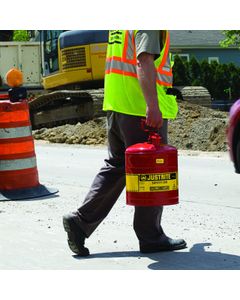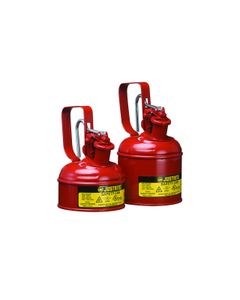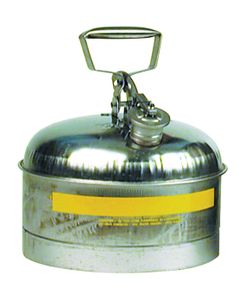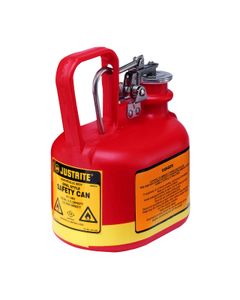Catégories
Bidon de sécurité de type I et type II
Nos bidons et conteneurs de sécurité offrent un stockage sûr pour les liquides inflammables dans les environnements de travail. Grâce à nos bidons de sécurité, les accidents et les risques d’incendie sont minimisés, ce qui protège les personnes et permet un lieu de travail plus sûr. Les bidons et conteneurs de sécurité Justrite sont conçus en tenant compte des codes de sécurité afin de répondre à une variété de réglementations de sécurité différentes.
Lire la suite

Bidons de sécurité de Type I 1001 Justrite bidons de sécurité Jaune Poignée pivotante
Protégez les travailleurs et réduisez les risques d'incendie en transférant, entreposant et distribuant des liquides inflammables selon les exigences de l'OSHA – Bidons de sécurité de type I à un seul bec
Disponible en 4 versions

Bidons de sécurité de Type I 1001 Justrite bidons de sécurité Rouge Poignée pivotante
Protégez les travailleurs et réduisez les risques d'incendie en transférant, entreposant et distribuant des liquides inflammables selon les exigences de l'OSHA – Bidons de sécurité de type I à un seul bec
Disponible en 5 versions

Bidons de sécurité de Type I 1001 Justrite bidons de sécurité Jaune Poignée à gâchette
Protégez les travailleurs et réduisez les risques d'incendie en transférant, entreposant et distribuant des liquides inflammables selon les exigences de l'OSHA – Bidons de sécurité de type I à un seul bec
Disponible en 2 versions

Bidons de sécurité de Type I 1001 Justrite bidons de sécurité Rouge Poignée à gâchette
Protégez les travailleurs et réduisez les risques d'incendie en transférant, entreposant et distribuant des liquides inflammables selon les exigences de l'OSHA – Bidons de sécurité de type I à un seul bec
Disponible en 3 versions

Bidons de sécurité AccuFlow™ de type II 1002 Justrite bidons de sécurité Jaune
Allez au-delà de la protection et de la conformité grâce à AccuFlow™ avec gâchette Safe-Squeeze permettant un versage sûr et contrôlé
Disponible en 5 versions

Bidons de sécurité AccuFlow™ de type II 1002 Justrite bidons de sécurité Rouge
Allez au-delà de la protection et de la conformité grâce à AccuFlow™ avec gâchette Safe-Squeeze permettant un versage sûr et contrôlé
Disponible en 6 versions

Bidons de sécurité en acier de Type I 133CN Eagle
Type I stainless steel safety cans are constructed of sturdy 24 gauge type 316 stainless steel with a stainless steel flame arrestor.
Disponible en 2 versions

Bidon de sécurité Poly de Type I 1406 Justrite bidons de sécurité
Bidons HPDE résistant aux produits chimiques et offrant un entreposage sûr pour les produits corrosifs inflammables dans un design peu encombrant
Disponible en 5 versions
FAQ sur Bidon de sécurité de type I et type II
What is the difference in a Type I & Type II Safety Can?
The Type I Safety Can has one opening that serves for both filling and dispensing. The Type II Safety Can has one opening dedicated to filling and a second spout opening dedicated to dispensing. The Type II Safety Can comes with an attached flexible hose and our exclusive AccuFlow™ manifold with Safe-Squeeze® trigger handle to provide the smooth and controlled pouring.
Can I transport gasoline in a safety can in my vehicle?
Yes, you can transport a safety can in a vehicle. Important points:
Secure safety can from movement.
Make sure the vehicle is well ventilated.
Do not store a safety can in a vehicle.
Take a safety can out of the vehicle when filling or dispensing.
Clean any fuel off the safety can before returning it to the vehicle
Are safety cans OK for outdoor use?
You most certainly can use safety cans outdoors. A lot of our customers do. There are some precautions to take with a safety can as well as any other container when outdoors:
1. When temperatures are hot, the vapor pressure in any safety can will be elevated. Safety cans are design to emergency pressure relief, rated at 3 to 5 psi. Still 3 to 5 psi can be significant. It is important to relieve that pressure in vapor space (while a safety can is setting flat) rather than liquid space (when tilted and dispensing liquid) to avoid a sudden burst of fluid and back splash.
2. When the temperature is warm and there is a sudden cooling, vacuum in the safety can will be created. There is no vacuum relief valve built into a safety can. While rare and depending on the fluid level in the safety can, the vacuum created can implode a safety can. This is more prevalent in desert locations. There are a couple of things you can do to prevent this:
Burp your safety cans at the end of the day to relieve pressure. The less difference in pressure, the less likely an implosion will occur.
Keep your cans shaded or tarped to minimize the temperature gain and pressure gain in the can.
Keep your safety can’s fluid level above half full.
3. Keeping your safety can in the shade can also minimize material loss. Gasoline as an example will boil at 100 degrees Fahrenheit. The pressure escaping is a liquid’s vapor escaping.
4. Always keep a safety can in a well-ventilated area. Never in a closed vehicle or passenger space.
5. And safely secure a safety can against movement in a vehicle from sudden braking or centrifugal forces.
6. Remember the US DOT’s material of trade rule as it applies to transporting gasoline in the course of performing one’s job; you are allowed a maximum of eight gallons in safety cans (i.e. 4 ea. 2 gal. safety cans).
7. Our metallic safety cans have a raised bottom to protect the bottom from puncture of sharp rocks and reinforcing ribs for resistance against side impacts.
¿Puedo almacenar nitrógeno líquido en una lata de seguridad?
Los materiales como el acero al carbón, el plástico y el caucho se vuelven quebradizos a temperaturas extremadamente bajas. El nitrógeno líquido se almacena en contenedores resistentes a impactos y especialmente aislados, que están ventilados para evitar la acumulación de presión. Esta gama de latas de seguridad NO está diseñada para almacenar nitrógeno líquido.






